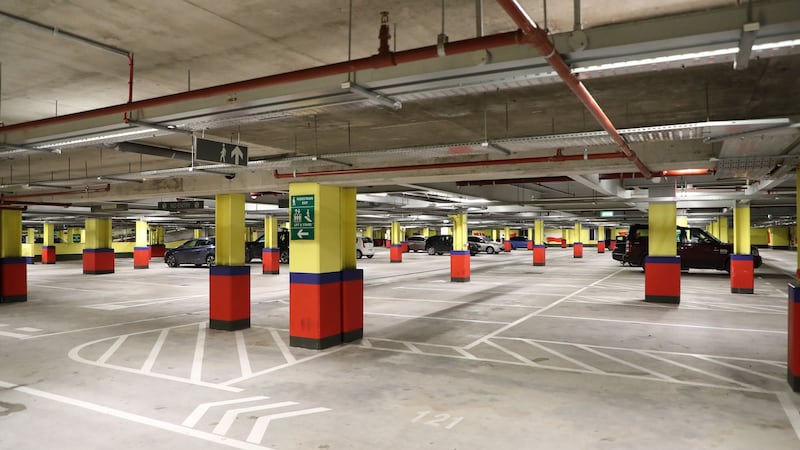The suggestion by the State's chief medical officer Dr Tony Holohan that car parks are full have been rejected by one of the country's biggest operators.
Euro Car Parks managing director
David Cullen said most city centre car parks are deserted and many others are closed during Level 5 lockdown.

Euro Car Park operates more than 200 car parks in Ireland, catering for between 70,000 and 80,000 cars.
“We have not got any evidence to support what he is saying, in fact quite the contrary. There are less people in now than in the first lockdown,” he said.
Last week, Dr Holohan expressed frustration that many people who could work from home are not doing so.
“Working from home - this message really hasn’t gotten through when you look at the traffic and when you look at what is going on the workplaces,” he said. “People will tell you stories that car parks are full and canteens are full in workplace settings. People are really not listening to this message.”
In response, Mr Cullen said there is no evidence for this claim from the car parks that he operates which are used for work purposes.
Mr Cullen said the car park at the Convention Centre Dublin, which also serves the Irish Financial Services Centre, currently has about 10 cars in on a daily basis parked and is only busy for sittings of the Dáil.
"We provide the parking for PriceWaterhouseCoopers. We had four cars in today. We would normally have 160."
The car park in Limerick city centre at Charlotte’s Quay, which is used by staff at the nearby the Revenue Commissioners office, is also closed.
Empty
The Brown Thomas car park in Dublin city centre is closed and the car park for the ILAC centre is predominantly for essential workers from the Rotunda Hospital, he said.
“Generally speaking, car parks operated by us operators are wide open and sitting there empty,” he added.
He said anecdotally there are car parks for some of the multinational companies on the fringes of Dublin that appear to be busy while the car park at The Point near the docks beoing used by construction workers, but they are the exceptions.
Michael Furey, the chief executive of Ronspot, said its car parks “are nowhere near full at the moment”. Ronspot is a Galway-based start-up which manages car parks on behalf of corporate clients.
Mr Furey said one company that he manages has 50 car parking spaces and an average of only one employee a day uses who uses it. Another has 90 spaces and 236 employees, but only two to three car parking spaces are used. A third company has 21 parking spaces and nobody uses it.
Bank of Ireland said only 15 per cent of its staff at head office are in the office and the rest are working from home.
Figures produced by Dublin City Council show that traffic volumes in the capital have stabilised during Level 5 at just under 70 per cent of pre-lockdown levels.
The council operates 33 different counting points between the Royal and Grand canals to monitor traffic volumes in and out of the city centre.
During the first lockdown in March and April, rush hour figures dropped to as low as 36 per cent of pre-Covid figures before rebounding to 80 per cent when restrictions were lifted during the summer.
There was a marked decline in traffic volumes after Level 5 restrictions were introduced on October 18th, with traffic dipping to 62 per cent of pre-pandemic levels in the first week. It has since increased since to 68 per cent, but remains well below pre-lockdown levels or levels reached during the summer.
Staying at home
The volumes of cycling during rush hour have declined to just 35 per cent of pre-Covid level, but off peak cycling figures are still exceeding 2019 figures. This indicates that cycling has become a lot more popular, but not for commuters who are staying at home.
The Dublin City Council figures also reveal a dramatic falling off in footfall in the city centre since all non-essential retail was closed under Level 5 restrictions. Before the lockdown, an average of more than 450,000 people a week entered the two main shopping streets of Grafton Street and Henry Street.
The post-Covid figures reached a high of 60 per cent during the summer but have since fallen back to about 150,000 people a week, a third of pre-lockdown levels.
AA spokesman Conor Faughan said its analysis is similar to Dublin City Council, the Central Statistics Office (CSO) and Transport Infrastructure Ireland (TII).
“From what we could see, our analysis seems to be tally with other observations. The second lockdown is twice as busy as the first one but significantly quieter than a normal November period.”
Mr Faughnan said the queues for car parks, which would be a feature of Christmas shopping starting around now, have not yet materialised. “We are seeing a very small percentage of what would be normal,” he said.











